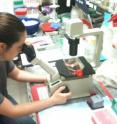UMass Amherst researchers unravel secrets of parasites' replication
A group of diseases that kill millions of people each year can't be touched by antibiotics, and some treatment is so harsh the patient can't survive it. They're caused by parasites, and for decades researchers have searched for a "magic bullet" to kill them without harming the patient. Now, a team of microbiologists at the University of Massachusetts Amherst has made an advance that could one day lead to a new weapon for fighting parasitic diseases such as African sleeping sickness, chagas disease and leishmaniasis. In the cover article of the current issue of Eukaryotic Cell, parasitologists Michele Klingbeil, doctoral candidate Jeniffer Concepción-Acevedo and colleagues report the first detailed characterization of the way key proteins in the model parasite Trypanosoma brucei organize to replicate its mitochondrial DNA (mtDNA). Understanding this spatial and temporal coordination could mean a foot in the door to launch new attacks on one of the parasites' essential cell processes, Klingbeil says.
She adds, "Parasites such as T. brucei, which causes African sleeping sickness, are not straightforward to treat because they're too much like our own cells. Antibiotics are ineffective, so we treat them as invaders, with toxic chemicals. We are trying to find their weaknesses so we can exploit those and eventually develop a very selective, effective and acceptable treatment."
Advances have not come easily, in part because these parasites have the most complex mitochondrial genome structure in nature, say Klingbeil and Concepción-Acevedo, the lead researcher on the project. To tackle it, they've focused on the trypanosome parasites' extremely complex method of mtDNA replication, which involves kinetoplast DNA or kDNA. Its core components are very unlike DNA replication in animals and human hosts, Klingbeil says, "so if we can inhibit the replication process and take away the kDNA, the parasites will die. That's one way we might be able to kill them."
Trypanosomes' kDNA is found as a nucleoid in the mitochondrion, where it holds many copies of catenated or networked minicircles and maxicircles that look like medieval chain mail under the microscope. These molecules pass information on to daughter cells via DNA polymerases whose job it is to copy all circles in the network. Trypanosomes have six mtDNA polymerases, while humans have just one.
To figure out how these trypanosomal polymerases know when to initiate DNA replication, Concepción-Acevedo set up immunofluorescence experiments focused on tracking a particular one, known as mtDNA polymerase ID (POLID). By fluorescent labeling the POLID protein and tracking it over space and time, Concepción-Acevedo quantified it and clarified its relationship to the overall replication process for the first time in a very discrete time window. The approach immediately paid off.
Klingbeil says, "As soon as Jeny began looking more closely at POLID localization she discovered a novel mechanism for how this protein participates in kDNA replication." In response to kDNA changes during the replication cycle, POLID was dynamically redistributing, or changing location, from the mitochondrial matrix to concentrated foci around the kDNA, and co-localizing with replicating kDNA molecules.
"This had been hypothesized, but never seen before," Klingbeil explains. It was amazing to witness. We visualized a mitochondrial replication protein undergoing dynamic localization for the first time, and linked it to DNA synthesis. No one had ever been able to do that in any mitochondrial DNA replication system before."
This important discovery explains how POLID engages in kDNA replication and opens up new avenues to study and intervene in mitochondrial protein dynamics, say the two parasitologists. Their ultimate success would be to find a chemical to inhibit POLID from carrying out its role during replication and target all parasites with kDNA structures.
This work was funded by the National Institutes of Health's National Institute of Allergy and Infectious Diseases. Support for Concepción-Acevedo also came from NSF's Northeast Alliance for Graduate Education and the Professoriate program.
Source: University of Massachusetts at Amherst
Other sources
- Secrets of parasites' replication unraveledfrom Science DailyTue, 10 Jul 2012, 19:00:21 UTC
- Researchers unravel secrets of parasites' replicationfrom PhysorgTue, 10 Jul 2012, 18:01:34 UTC
